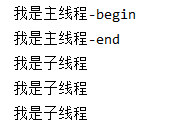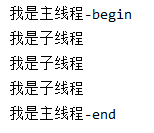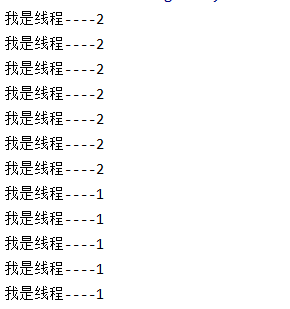java多线程-初探(一)
常见的线程函数
| sleep | 当前线程暂停 |
| join | 加入到当前线程中 |
| setPriority | 线程优先级 |
| yield | 临时暂停 |
| setDaemon | 守护线程 |
sleep
当前线程休眠具体的毫秒值后唤醒。
InterruptedException异常:当线程休眠时异常中断将抛出此异常。
class Main
package com.thread.two;
public class Main {
/**
* 吃饭
* @param args
*/
public static void main(String[] args) {
new Thread(){
public void run(){
long beginTime = System.currentTimeMillis();
System.out.println("执行前毫秒数:" + beginTime);
// 执行sleep函数。当前调用的线程休眠固定毫秒数
try {
Thread.sleep(2000);
} catch (InterruptedException e) {
e.printStackTrace();
}
long endTime = System.currentTimeMillis();
System.out.println("执行结束毫秒数:" + endTime);
System.out.println("执行花了:" + (endTime - beginTime)/1000 +"秒");
}
}.start();
}
}
执行结果

join
将当前线程加入到主线程。当前线程执行完成,主线程才能接着往下执行。
主线程:执行main函数时,整个进程是一个主线程,主线程从上往下依次执行,遇到Thread类开启多线程时,线程类独立执行,不影响主线程的执行步骤,就是说子线程独立执行,主线程还是往下继续执行。但是当子线程调用join函数加入到主线程当中,则主线程必须等子线程执行完成才能往下继续执行。
class Main
package com.thread.two;
public class Main {
/**
* 吃饭
* @param args
*/
public static void main(String[] args) {
/*new Thread(){
public void run(){
long beginTime = System.currentTimeMillis();
System.out.println("执行前毫秒数:" + beginTime);
// 执行sleep函数。当前调用的线程休眠固定毫秒数
try {
Thread.sleep(2000);
} catch (InterruptedException e) {
e.printStackTrace();
}
long endTime = System.currentTimeMillis();
System.out.println("执行结束毫秒数:" + endTime);
System.out.println("执行花了:" + (endTime - beginTime)/1000 +"秒");
}
}.start();*/
// join
System.out.println("我是主线程-begin");
Thread thread = new Thread() {
public void run(){
// 每个一秒打印一次:我是子线程
for(int i = 0 ; i < 3 ; i++){
System.out.println("我是子线程");
try {
Thread.sleep(1000);
} catch (InterruptedException e) {
e.printStackTrace();
}
}
}
};
thread.start();
// thread.join();
System.out.println("我是主线程-end");
}
}
注释thread.join();的执行结果

打开thread.join();的执行结果

setPriority
设置线程的优先级,取值范围:1-10
线程优先级越高,该线程越容易获得cpu资源,从而执行自身线程,相较于其他低优先级的线程优先执行。
class Main
package com.thread.two;
public class Main {
/**
* 吃饭
* @param args
*/
public static void main(String[] args) {
/*new Thread(){
public void run(){
long beginTime = System.currentTimeMillis();
System.out.println("执行前毫秒数:" + beginTime);
// 执行sleep函数。当前调用的线程休眠固定毫秒数
try {
Thread.sleep(2000);
} catch (InterruptedException e) {
e.printStackTrace();
}
long endTime = System.currentTimeMillis();
System.out.println("执行结束毫秒数:" + endTime);
System.out.println("执行花了:" + (endTime - beginTime)/1000 +"秒");
}
}.start();*/
/*// join
System.out.println("我是主线程-begin");
Thread thread = new Thread() {
public void run(){
// 每个一秒打印一次:我是子线程
for(int i = 0 ; i < 3 ; i++){
System.out.println("我是子线程");
try {
Thread.sleep(1000);
} catch (InterruptedException e) {
e.printStackTrace();
}
}
}
};
thread.start();
try {
thread.join();
} catch (InterruptedException e) {
e.printStackTrace();
}
System.out.println("我是主线程-end");*/
// setPriority线程优先级
// 线程1
Thread thread1 = new Thread(){
public void run(){
for (int i = 0 ; i < 100 ; i++){
System.out.println("我是线程----1");
}
}
};
// 线程二
Thread thread2 = new Thread(){
public void run(){
for (int i = 0 ; i < 100 ; i++) {
System.out.println("我是线程----2");
}
}
};
// 设置优先级 取值:1-10
thread1.setPriority(Thread.MIN_PRIORITY);// 最小
thread2.setPriority(Thread.MAX_PRIORITY);// 最大
thread1.start();
thread2.start();
}
}
数据量小无法体现,这里只截部分执行结果

yield
临时暂停当前线程,使得其余线程能更容易获得cpu资源执行。
class Main
package com.thread.two;
public class Main {
/**
* 吃饭
* @param args
*/
public static void main(String[] args) {
/*new Thread(){
public void run(){
long beginTime = System.currentTimeMillis();
System.out.println("执行前毫秒数:" + beginTime);
// 执行sleep函数。当前调用的线程休眠固定毫秒数
try {
Thread.sleep(2000);
} catch (InterruptedException e) {
e.printStackTrace();
}
long endTime = System.currentTimeMillis();
System.out.println("执行结束毫秒数:" + endTime);
System.out.println("执行花了:" + (endTime - beginTime)/1000 +"秒");
}
}.start();*/
/*// join
System.out.println("我是主线程-begin");
Thread thread = new Thread() {
public void run(){
// 每个一秒打印一次:我是子线程
for(int i = 0 ; i < 3 ; i++){
System.out.println("我是子线程");
try {
Thread.sleep(1000);
} catch (InterruptedException e) {
e.printStackTrace();
}
}
}
};
thread.start();
try {
thread.join();
} catch (InterruptedException e) {
e.printStackTrace();
}
System.out.println("我是主线程-end");*/
/*// setPriority线程优先级
// 线程1
Thread thread1 = new Thread(){
public void run(){
for (int i = 0 ; i < 100 ; i++){
System.out.println("我是线程----1");
}
}
};
// 线程二
Thread thread2 = new Thread(){
public void run(){
for (int i = 0 ; i < 100 ; i++) {
System.out.println("我是线程----2");
}
}
};
// 设置优先级 取值:1-10
thread1.setPriority(Thread.MIN_PRIORITY);// 最小
thread2.setPriority(Thread.MAX_PRIORITY);// 最大
thread1.start();
thread2.start();*/
// yield 临时暂停
// 线程1
Thread thread1 = new Thread(){
public void run(){
for (int i = 0 ; i < 100 ; i++){
System.out.println("我是线程----1");
}
}
};
// 线程二
Thread thread2 = new Thread(){
public void run(){
for (int i = 0 ; i < 100 ; i++) {
// 执行一半临时暂停
if (i == 50) Thread.yield();
System.out.println("我是线程----2");
}
}
};
thread1.start();
thread2.start();
}
}
执行结果

setDaemon
守护线程,当一个进程里全部都是守护线程时,结束当前整个进程。
守护线程一般用作业务附加的辅助功能,如进程执行的记录日志、检测当前用户状态。
class Main
package com.thread.two;
public class Main {
/**
* 吃饭
* @param args
*/
public static void main(String[] args) {
/*new Thread(){
public void run(){
long beginTime = System.currentTimeMillis();
System.out.println("执行前毫秒数:" + beginTime);
// 执行sleep函数。当前调用的线程休眠固定毫秒数
try {
Thread.sleep(2000);
} catch (InterruptedException e) {
e.printStackTrace();
}
long endTime = System.currentTimeMillis();
System.out.println("执行结束毫秒数:" + endTime);
System.out.println("执行花了:" + (endTime - beginTime)/1000 +"秒");
}
}.start();*/
/*// join
System.out.println("我是主线程-begin");
Thread thread = new Thread() {
public void run(){
// 每个一秒打印一次:我是子线程
for(int i = 0 ; i < 3 ; i++){
System.out.println("我是子线程");
try {
Thread.sleep(1000);
} catch (InterruptedException e) {
e.printStackTrace();
}
}
}
};
thread.start();
try {
thread.join();
} catch (InterruptedException e) {
e.printStackTrace();
}
System.out.println("我是主线程-end");*/
/*// setPriority线程优先级
// 线程1
Thread thread1 = new Thread(){
public void run(){
for (int i = 0 ; i < 100 ; i++){
System.out.println("我是线程----1");
}
}
};
// 线程二
Thread thread2 = new Thread(){
public void run(){
for (int i = 0 ; i < 100 ; i++) {
System.out.println("我是线程----2");
}
}
};
// 设置优先级 取值:1-10
thread1.setPriority(Thread.MIN_PRIORITY);// 最小
thread2.setPriority(Thread.MAX_PRIORITY);// 最大
thread1.start();
thread2.start();*/
/*// yield 临时暂停
// 线程1
Thread thread1 = new Thread(){
public void run(){
for (int i = 0 ; i < 100 ; i++){
System.out.println("我是线程----1");
}
}
};
// 线程二
Thread thread2 = new Thread(){
public void run(){
for (int i = 0 ; i < 100 ; i++) {
// 执行一半临时暂停
if (i == 50) Thread.yield();
System.out.println("我是线程----2");
}
}
};
thread1.start();
thread2.start();*/
// setDaemon 守护线程
System.out.println("主线程开始");
Thread thread = new Thread(){
public void run(){
while (true){
try {
Thread.sleep(1);
} catch (InterruptedException e) {
e.printStackTrace();
}
System.out.println("我是守护线程!");
}
}
};
thread.setDaemon(true);
thread.start();
System.out.println("主线程结束");
}
}
执行结果

主线程结束,守护线程也相应结束,不会继续执行。
当所有线程都是守护线程时,进程结束执行。